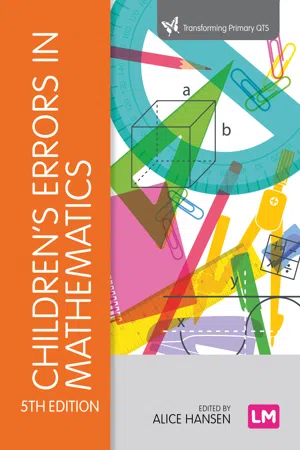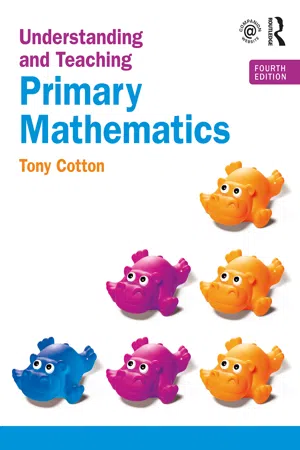Fractions, Decimals and Percentages
Fractions, decimals, and percentages are different ways of representing parts of a whole. Fractions express a part of a whole as a ratio of two numbers, decimals represent the same information in a different format, and percentages are a way of expressing a fraction or a decimal as a portion out of 100. These concepts are fundamental in understanding and working with numbers.
8 Key excerpts on "Fractions, Decimals and Percentages"
- eBook - ePub
- Alice Hansen, Doreen Drews, John Dudgeon, Fiona Lawton, Liz Surtees(Authors)
- 2020(Publication Date)
- Learning Matters(Publisher)
...The conceptual ideas underpinning decimals are the same as those underpinning fractions: for example, part of a whole, part of a set and so on (see the discussion in the ‘Fraction’ section above). In effect, decimals are simply another way of representing fractions in written form. The implication of this is that children need to have a sound understanding of fractions in order to use abstract decimal notation to represent fractions. Pagni (2004) argues that fractions and decimals should not be taught separately. Since fractions and decimals are representations for the same numbers, Pagni suggests teachers should show the connection between them by placing equivalent fractions and decimals on a number line. Errors in the use of decimals are likely to have two sources of misunderstanding: place value and fractions (Moloney and Stacey, 1997). Where such errors occur, teachers might consider returning to much earlier concepts to ensure the child has sufficient understanding of these ideas to be able to use decimal notation. According to Sadi (2007), more children have difficulties with decimals than any other number concept. He suggests that this is because of the gap in understanding between the natural numbers and decimal numbers. Percentages The term ‘per cent’ means literally ‘for every hundred’. Percentages are conceptually equivalent to the part-of-a-set interpretation of fractions − if our set contains 100 objects then we can easily see that if 50 of the objects have a particular attribute then 50 per cent (%) of the set can be said to have the attribute. Equally, we can relate percentages to the part–whole representation of fractions in that ‘the whole’ represents 100%. Percentages are used widely in ‘everyday’ life and children will have an understanding that 30% off in the sale means that the item is reduced in price...
- eBook - ePub
- Valsa Koshy, Ron Casey, Paul Ernest, Valsa Koshy, Ron Casey, Paul Ernest(Authors)
- 2014(Publication Date)
- Routledge(Publisher)
...Supermarkets and department stores use these all the time. Children need to be familiar with these ideas. When we measure using arbitrary units, for example when moving furniture at home, for sewing or for cooking, we often use the concept of fractions. Decimal numbers, which are an extension of the place value system, are based on the idea of fractions. Percentages and ratio are also concepts related to fractions. Learning how to operate on fractions is necessary for tackling algebraic work and for undertaking calculations in probability. 3.2 Decimals Decimal numbers can be thought of as combined integers (whole numbers) and fractions restricted to those with denominators which are multiples of ten. The decimal numbers form what is called the denary system, based on ten, just as binary numbers form what is called the binary system, based on two. The decimal numbers incorporate the notion of place value, but extend it beyond the integers to its fractional parts. The separation of its integer and fractional parts is accomplished by a simple and ingenious device, the decimal point. This is one example of a section of mathematics in which the choice of sign creates the possibility of enormous thinking development. One question of interest, which will to be dealt with later, is the mathematical connection between decimal numbers and the integers and fractions. For the moment let us be concerned with the practical importance of decimal numbers in decimal currency systems. Pounds sterling is a decimal currency. One pound is equivalent to one hundred pence. In more mathematical notation this is written as: £1 = 100p. This enables prices to be written in decimal form, such as £4.37. The number read as ‘four point three seven’, however, is written as 4 · 37. The difference between the two is just the position of the point...
- eBook - ePub
RtI in Math
Evidence-Based Interventions
- Linda Forbringer, Wendy Weber(Authors)
- 2021(Publication Date)
- Routledge(Publisher)
...Creating a model helps students understand the effects of dividing by a decimal, as illustrated in Figure 11.28. Figure 11.28 Modeling Dividing by a Decimal Decimals are typically introduced in fourth grade. Although there is strong research support for using manipulatives and pictures to introduce any new concept or procedure, operations with decimals are too often introduced as rote procedures. Although students may learn to execute the computations accurately, they will have trouble applying their knowledge in problem-solving situations if they do not understand the underlying principles. Because upper elementary and middle school math materials currently rely on abstract representation for most lessons (Alkhateeb, 2019 ; Gersten et al., 2009 ; van Garderen, Scheuermann, Poch, & Murray, 2018), interventionists will frequently need to add concrete and visual representation activities to support students who receive tiered interventions. Percent Percentages are commonly encountered in everyday situations. Meteorologists report the chance of storms as a percentage: “There is a 40 percent chance of rain today.” Sales tax and income tax are calculated based on a percentage of cost or income. The term “percent” derives from the Latin meaning “per hundred,” and percent provides another way to represent fractional or decimal hundredths. We can therefore use the same models we introduced for fractions and decimals to represent percent. Activities that explicitly link fraction-decimal-percent equivalents can help students construct an understanding of percent. For example, we can shade a portion of a 100-square section of graph paper and express the quantity as a fraction, a decimal, and a percent, as shown in Figure 11.29. Figure 11.29 Fraction-Decimal-Percent Equivalents Our representations should include quantities greater than one as well as models of quantities less than one...
- Sandra Rush(Author)
- 2013(Publication Date)
- Research & Education Association(Publisher)
...Chapter 3 The Parts of the Whole Decimals, fractions, and percentages are all closely related. For example, to say that 5 is half of 10 can be represented as.50 × 10, ½ of 10, or 50% of 10. This chapter discusses each of these types of calculations in detail. Decimals The four operations on decimals are essentially the same as for whole numbers with special attention given to the placement of the decimal point in the answer. Zeros can be filled in as placeholders to the left of a whole number (00123 is the same as 123), or to the right of a decimal (.45600 is the same as.456). The word decimal comes from the Latin word that means “10.” Our counting system (as we saw in Chapter 2) as well as our monetary system are based on the number 10. Just as our placeholders were ones, tens, hundreds, and so forth, for whole numbers, decimals indicate parts of units, with placeholders of tenths, hundredths, thousandths, and so on. The decimals appear after a decimal point (.) and get smaller as the numbers go to the right. C ALCULATOR BASIC ARITHMETIC The important keys for addition, subtraction, multiplication, and division are the parentheses keys and above the number pad, as well as. For addition, enter the first number, then, then the next number, etc., then. For subtraction, enter the first number, then, then the next number, etc., then. For multiplication, enter the first number, then, then the next then. The multiplication sign on the screen will change to *. For division, enter the dividend (the number that is to be divided, or the numerator, the top number on a fraction), then, then the divisor (the number being divided into the dividend, or the denominator, the bottom number on a fraction), then. For any of the operations or any combination of operations, if any of the entries involve more than one term or factor, use parentheses or the answer might not be correct. For example, if you want to multiply 6 × (2 – 5), enter it just that way, with the parentheses, and press...
- eBook - ePub
Teaching Mathematics in Primary Schools
Principles for effective practice
- Robyn Jorgensen(Author)
- 2020(Publication Date)
- Routledge(Publisher)
...CHAPTER 11 RATIONAL NUMBER Topics that fall under the heading of rational number include fractions, decimals, ratio and proportion, rate and per cent. These topics are linked mathematically, but conceptually they are subtly different. In this chapter, key ideas associated with the topics of fractions, decimals, ratio, rate, proportion and per cent and their interlinked nature are presented. Approaches for enhancing students' knowledge of these topics are described. Common and decimal fractions Fractional numbers can be represented in fraction form (e.g.¼) and in decimal form (e.g. 0.25), and the terms 'common fraction' and 'decimal fraction', respectively, are used to distinguish the two symbolic representations. The word fraction is frequently applied to numbers in both fraction form and decimal form, yet there are subtle conceptual differences between common fractions and decimal fractions. Common fraction understanding is based on the part-whole concept. Decimal fraction understanding stems from a combination of an understanding of common fractions, and whole number and place value knowledge. For simplification, in this chapter common fractions are referred to as 'fractions', and decimal fractions as 'decimals'. Whole number and rational number connections Whole number understanding provides the foundation for understanding of rational numbers. Particular rational number topics provide a foundation as well as a link to other rational number topics. Decimal understanding is connected to both fraction and whole number knowledge. Ratio and proportion understanding links to fractions, as well as to multiplicative thinking developed through the study of whole numbers. Rate links to ratio. Per cent links to decimals and fractions, and to ratio and proportion. The interconnected nature of rational number topics to each other and to whole number is depicted in the accompanying flowchart...
- eBook - ePub
- Tony Cotton(Author)
- 2020(Publication Date)
- Routledge(Publisher)
...They are usually taught separately, which leads to children not making the link between the three ideas. In fact, they are just three different ways of representing numbers. It is very useful to move between the three representations as this allows us to see mathematics as connected rather than separate. It also allows us to draw on our understanding of one area of mathematics to solve problems in another area. Fractions are ‘parts’ of whole numbers. We need to be able to describe ‘parts’ of whole numbers for two reasons. First, when measuring we can’t be sure that a length or weight will also be a whole number. Second, when we ‘share’ or divide numbers there are many occasions when the result of the division is not an integer, so we need a way of writing an answer that is not an integer. We call this a fraction. Terezinha Nunes and Peter Bryant have explored for many years the ways in which children understand fractions. In 1996 Blackwell published their book called Children Doing Mathematics, in which they suggest that understanding fractions is not simply a case of extending the knowledge we have of whole numbers. There are key differences. For example, a whole number can only be represented in one way: if we count three objects, we will write 3. However, there are classes of fractions. For example, 1 4 is the same as 2 8, 4 16 or even 25% or 0.25. Fractions are also used for different purposes and appear to mean different things in different cases. So, if a fraction represents part of a whole, the denominator represents the number of parts into which the whole has been ‘cut’ and the numerator represents the number of parts taken. In the fraction, 5 is the numerator and 7 is the denominator. Nunes and Bryant suggest that children have to come to an understanding of two key ideas: • First, that for the same denominator, the larger the numerator, the larger the fraction...
- eBook - ePub
- John Bird(Author)
- 2019(Publication Date)
- Routledge(Publisher)
...Chapter 2 Fractions, Decimals and Percentages Why it is important to understand: Fractions, Decimals and Percentages Engineers use fractions all the time, examples including stress to strain ratios in mechanical engineering, chemical concentration ratios and reaction rates, and ratios in electrical equations to solve for current and voltage. Fractions are also used everywhere in science, from radioactive decay rates to statistical analysis. Calculators are able to handle calculations with fractions. However, there will be times when a quick calculation involving addition, subtraction, multiplication and division of fractions is needed. Real life applications of ratio and proportion are numerous. When you prepare recipes, paint your house, or repair gears in a large machine or in a car transmission, you use ratios and proportions. Trusses must have the correct ratio of pitch to support weight of roof and snow, cement must be the correct mixture to be sturdy, and doctors are always calculating ratios as they determine medications. Almost every job uses ratios one way or another: ratios are used in building & construction, model making, art & crafts, land surveying, die and tool making, food and cooking, chemical mixing, in automobile manufacturing and in airplane and parts making. Engineers use ratios to test structural and mechanical systems for capacity and safety issues. Millwrights use ratio to solve pulley rotation and gear problems. Operating engineers apply ratios to ensure the correct equipment is used to safely move heavy materials such as steel on worksites. It is therefore important that we have some working understanding of ratio and proportion. Engineers and scientists also use decimal numbers all the time in calculations...
- eBook - ePub
Numeracy in Nursing and Healthcare
Calculations and Practice
- Pearl Shihab(Author)
- 2014(Publication Date)
- Routledge(Publisher)
...Chapter 2 Decimals and other fractions How to deal with the bits and pieces DOI: 10.4324/9781315735092-2 When drugs come from the manufacturer they are in doses to suit most adult patients. However, many of your patients will be very young or very old and they need smaller doses. You may need to calculate the correct amount by taking part or a fraction of the standard dose, so you need to understand how to work out fractions. When you have completed this chapter, you should be able to Add, subtract, multiply and divide vulgar fractions. Add, subtract, multiply and divide decimal fractions. Convert decimal fractions to vulgar fractions. Convert vulgar fractions to decimal fractions. Meet some of the numeracy outcomes in the Essential Skills Clusters (NMC 2010): (2) Accurately monitors dietary and fluid intake and completes relevant documentation. (1) Takes and records accurate measurements of weight, height, length, body mass index and other measures of nutritional status. (2) Accurately monitors and records fluid intake and output. (1) Is competent in basic medicine calculations. (2) Is competent in the process of medication-related calculations in the nursing field. In Chapter 1 you got to grips with the four basic operations of arithmetic using whole numbers...







